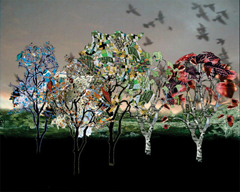The User Experience of Interactive Art: Boston CyberArts Festival 2005
Prompted by curiousity, and a desire to see if interactive art really is irritating, I took in several exhibits for the 2005 Boston CyberArts Festival, at the Decordova Museum this weekend.
Sarah Boxer’s review of Trains – a landscape made of tiny model railroad buildings and figures, adorned with movie images from famous movie scenes, and populated by passengers that appear only on the video screen of a Gameboy – offers several stellar insights about the emotionally unhealthy states of mind brought on by attempting to interact with computerized interfaces. Boxer says:
Alas, some cyberworks combine all the annoyances of interactive art (prurience, ritual, ungraciousness and moral superiority) to produce a mega-annoyance: total frustration. Case in point: John Klima’s “Trains,” at the DeCordova Museum School Gallery, in the Boston suburb Lincoln, which is a model train set guided by cellphone.
It’s clear from this that the emotional or other content of the art installation itself was obscured by the user experience Boxer had to negotiate in order to engage with the piece. Boxer’s expectations for user experience quality might have been lower if she were trying out a new spreadsheet, or Lotus Notes, but that’s just an example of how the software industry has trained customers to expect abusively bad experiences. See photos of Trains here.
One of the more usable – if that judgement applies – is Nam June Paik’s “Requiem for the 20th Century“. Requiem – photo here – according to Boxer is less annoying “…a relief to just stand there and watch the apocalyptic montage! No interaction. No instruction. No insults.”
Once past the interface, I found Requiem elegiac as expected, but unsatisfying for two reasons: first by virtue of concerning mostly Paik’s work in video art, and second by being strangely empty at heart (or was that the point?). The svelte physicality of the Chrysler Airstream art-deco automobile contrasted sharply with the ephemeral nature of the video images showing on it’s windows, in a clear example of concepts that were well-thought-through, but in the end, this is another example of art (post modern and/or otherwise) that is clever, yet incapable of engaging and establishing emotional resonance. “Requiem” is not even effectively psychological, which would broaden it’s potential modes of address. To ameliorate this weakness, I recommend obtaining the audiobook version of J.G. Ballard’s “Crash“, and listening to it’s auto-erotic on headphones while taking in the silvered spectacle.
From the description: “Requiem sums up the twentieth century as a period of transformative socio-cultural change from an industrial based society to an electronic information based society. The automobile and the television figure as both the most significant inventions of the century as well as the most prominent signifiers of Western consumerism.”
The most interesting installation was a wiki based soundscape, the first example I know of in which information architecture becomes both medium and art.
From the official description of the festival:
The creative connection between two of Boston’s most vital forces – the arts community and the high-tech industry – is once again in the spotlight, with more than 70 exhibitions and events in and around the Boston area from April 22 through May 8. It’s the first and largest collaboration of artists working in new technologies in all media in North America, encompassing visual art, dance, music, electronic literature, web art, and public art.
Related posts:
